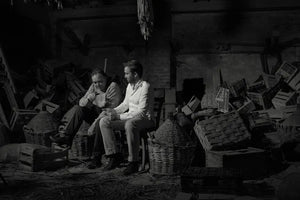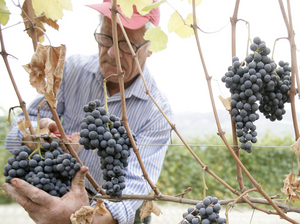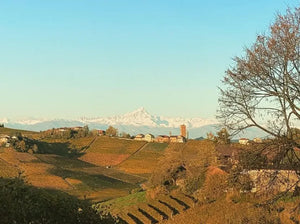Blog » Piedmont
-
Barolo's Royal Family: Giuseppe RinaldiRinaldi is a revered traditionalist following family techniques used since the early and mid-1900s. With long macerations on the skins aging in large botti, the results are powerfully deep Baroli met with precision and aromatics that make them incomparable. They offer wild spices, gamey notes, and of course, Nebbiolo's tell-tale tar and roses.The Giuseppe Rinaldi wines first appeared in 1921, though, it was during Beppe's lifetime that the world's attention turned toward Piedmont—Beppe's spirit is more immortalized than the legendary wines he produced. Sadly, he passed away in 2018, but he had several years to see his daughters, Marta and Carlotta, continue to raise the bar.
I visited the Rinaldi cantina just before harvest in 2012. It was nothing short of a privilege to meet the Rinaldi family and taste the wines, including the monumental 2010s still in botti. Finding back-vintage wines is not a common occurrence today, and I was thrilled to work with Rinaldi's US importer, Vinifera Imports, to acquire several older wines directly from the Rinaldi estate. -
Time Turned Back: Roagna Barolo & BarbarescoAt Roagna, throwback methods on vinification and aging meet modern sophistication of grace and translucency. Articulating how Luca Roagna's wines deviate from other names in the unanimous top tier of Piedmont can be challenging. But, again, the beauty of Nebbiolo from these adjacent regions has always extended beyond common vocabulary. Luca's words ton the combination of limestone and sand strike at the heart of the mentality at Roagna:"You find more finesse, more elegance, less color, less alcohol, and when we have less color and alcohol, we are really happy." — Luca Roagna
Longtime fans of Piedmont will recognize the enviable stable of prized vineyards here: Asili, Paje, Montefico, Gallina, Faset Pira, and Rocche. Native fermentation lasts ten days in large wood, finishing with a submerged cap ("cappello sommerso") for 60-90 days. Afterward, aging takes place in large, neutral botti. Instead of toasting by flame, casks are steamed to exclude any charring flavor. This cask aging takes place for 5 years before release.If you love taut Barolo and Barbaresco with intrinsic tannin melded into transparent wines of explosive aromatics ending with a wispy, ethereal ethos, you will be at the correct address. -
Piedmont Perfection: Giacomo Conterno Barolo
In 2019, Roberto Conterno released only one Barolo, the Cerretta from Serralunga d'Alba. Arione and Vigna Francia will be put into the Riserva Monfortino for later release. Though also located in Serralunga, Cerretta shares a soil composition reminiscent of what's found across the valley in La Morra, where more elegant and less statuesque Barolos are commonly seen. The 2019 has bright red and black fruits with incredible focus, delineation, and a crystalline sense of purity that I love.
The King of Wines and the Wine of Kings. If one producer was tied to this moniker, it's undoubtedly Barolo's Roberto Conterno. From Giacomo to Giovanni to Roberto, this estate has been the standard bearer for the grandest wines in Italy—Nebbiolo from Serralunga d'Alba.
Visiting with Roberto in November 2012 offered a glimpse into the genius behind his quiet and reserved exterior. Conterno's immaculate cellar and eye for detail, specifically with cleanliness, are unlike anything I've seen in person. The methods here are traditional through and through. Still, one could point to vineyard practices as relatively modern, with a reliance on coaxing maximum ripeness from vines—I find this to be a massive element in why the dark and tannic Nebbiolo of Serralunga's terroir exudes so much charm when poured.
Purchased in 1974 by Giovanni Conterno, the flagship Francia is about the melding of power and finesse. Arione debuted in 2015, and now, with four releases under the stewardship of Roberto, we get to see even darker and more intense Serralunga terroir, where iron-tinged minerality meets lavender, orange peel, and menthol. -
Starbright Secret: Piero Busso Barbaresco
The 2016 vintage in Piedmont doesn't need an introduction, but the name Piero Busso might. Among the perfect vintage's success stories, Piero's Barbaresco from the Gallina cru has it all. The famous vineyard from Nieve is likely better known for Bruno Giacosa and Luca Roagna. Still, Piero's expression floored us for its immediacy yet age-worthy structure.
This Gallina is all about perfume and bright aromatics, like the best 2016s show in spades. On the palate, a thrilling concentration of red berries with mint have loads of gripping intensity, and the finish is classic Barbaresco with that more dusty minerality finely woven through, compared to Barolo's broader tannic personality.
A sense of grace and understated elegance jumps out of the glass. When we all tried our first sip in San Diego, we looked at each other and knew the obvious greatness captured in this 2016 rendition. While Piero Busso and his Gallina Barbaresco are always a match made in heaven, this exceptional vintage is drinking beautifully right now with so much upside in the cellar.
.svg?v=162776257677185172071724397232)






